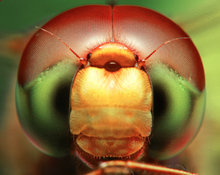
Back تصوير الماكرو Arabic Macrofotografia Catalan Makrofotografie Czech Makrofotografi Danish Makrofotografie German Μακροφωτογραφία Greek Macrofotografía Spanish Makroargazkilaritza Basque عکاسی ماکرو Persian Lähikuvaus Finnish




Macro photography (or photomacrography[1][2] or macrography,[3] and sometimes macrophotography[4]) is extreme close-up photography, usually of very small subjects and living organisms like insects, in which the size of the subject in the photograph is greater than life-size (though macrophotography also refers to the art of making very large photographs).[3][5] By the original definition, a macro photograph is one in which the size of the subject on the negative or image sensor is life-size or greater.[6] In some senses, however, it refers to a finished photograph of a subject that is greater than life-size.[7]
The ratio of the subject size on the film plane (or sensor plane) to the actual subject size is known as the reproduction ratio. Likewise, a macro lens is classically a lens capable of reproduction ratios of at least 1:1, although it often refers to any lens with a large reproduction ratio, despite rarely exceeding 1:1.[7][8][9][10]
Apart from technical photography and film-based processes, where the size of the image on the negative or image sensor is the subject of discussion, the finished print or on-screen image more commonly lends a photograph its macro status. For example, when producing a 6×4-inch (15×10-cm) print using 35 format (36×24 mm) film or sensor, a life-size result is possible with a lens having only a 1:4 reproduction ratio.[11][12]
Reproduction ratios much greater than 10:1 are considered to be photomicrography, often achieved with digital microscope (photomicrography should not be confused with microphotography, the art of making very small photographs, such as for microforms).
Due to advances in sensor technology, today's small-sensor digital cameras can rival the macro capabilities of a DSLR with a "true" macro lens, despite having a lower reproduction ratio, making macro photography more widely accessible at a lower cost.[9][13] In the digital age, a photograph is more practically defined as macro when an object measuring 24 mm or less either matches the frame's height or is larger.[14]
- ^ Thomas Clark (2011). Digital Macro and Close-Up Photography For Dummies. John Wiley & Sons. p. 29. ISBN 978-1-118-08920-0.
- ^ Freeman, Michael (2010). Mastering Digital Photography. UK: ILEX Press. p. 336. ISBN 978-1-907579-00-4.
- ^ a b Graham Saxby (2010). The Science of Imaging: An Introduction (2nd ed.). CRC Press. p. 269. ISBN 978-1-4398-1286-0.
- ^ Webster, Merriam (1996). Collegiate Dictionary, 10th Ed. Merriam-Webster, Inc. p. 698. ISBN 0-87779-711-0.
- ^ Michael Freeman (2010). The DSLR Field Guide: The Essential Handbook to Getting the Most from Your Camera. Focal Press. p. 30. ISBN 978-0-240-81720-0.
- ^ Marom, Erez. "Macro photography: Understanding magnification". Retrieved 20 May 2012.
- ^ a b Photography.com. "Macro Photography". Archived from the original on 2008-11-06. Retrieved 20 May 2012.
- ^ Rockwell, Ken. "Canon 50 mm Macro". Retrieved 20 May 2012.
- ^ a b Cambridge in Colour. "Macro Camera Lenses".
- ^ Long, Ben. "How to take great macro photographs". Retrieved 20 May 2012.
- ^ Olympus. "Macrophotography and your Evolt". Retrieved 20 May 2012.
- ^ Super Tight Stuff. "Incredible Macro Insect Photos". Retrieved 20 May 2012.
- ^ Frank, Bob. "Extreme macro photography". Retrieved 20 May 2012.
- ^ Wattie, John. "Digital Stereo Macro Photography". Retrieved 20 May 2012.
© MMXXIII Rich X Search. We shall prevail. All rights reserved. Rich X Search